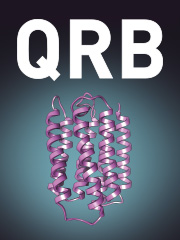Crossref Citations
This article has been cited by the following publications. This list is generated based on data provided by
Crossref.
Pieri, Carlo
Recchioni, Rina
Moroni, Fausto
Balkay, László
Márián, Teréz
Trón, Lajos
and
Damjanovich, Sándor
1989.
Ligand and voltage gated sodium channels may regulate electrogenic pump activity in human, mouse and rat lymphocytes.
Biochemical and Biophysical Research Communications,
Vol. 160,
Issue. 3,
p.
999.
Mátyus, László
Pieri, Carlo
Recchioni, Rina
Moroni, Fausto
Bene, László
Trón, Lajos
and
Damjanovich, Sándor
1990.
Voltage gating of Ca2+-activated potassium channels in human lymphocytes.
Biochemical and Biophysical Research Communications,
Vol. 171,
Issue. 1,
p.
325.
Jona, Istvan
Matko, Janos
and
Martonosi, Anthony
1990.
Structural dynamics of the Ca2+-ATPase of sarcoplasmic reticulum. Temperature profiles of fluorescence polarization and intramolecular energy transfer.
Biochimica et Biophysica Acta (BBA) - Biomembranes,
Vol. 1028,
Issue. 2,
p.
183.
Trón, Lajos
Pieri, Carlo
Márián, Teréz
Balkay, László
Emri, Miklós
and
Damjanovich, Sándor
1990.
Bretylium causes a K+-Na+ pump activation that is independent of Na+H+ exchange in depolarized rat, mouse and human lymphocytes.
Molecular Immunology,
Vol. 27,
Issue. 12,
p.
1307.
Vereb, György
Panyi, György
Balázs, Margit
Mátyus, László
Matkó, János
and
Damjanovich, Sándor
1990.
Effect of cyclosporin A on the membrane potential and Ca2+ level of human lymphoid cell lines and mouse thymocytes.
Biochimica et Biophysica Acta (BBA) - Bioenergetics,
Vol. 1019,
Issue. 2,
p.
159.
Rivière, Marie-Emmanuel
Grand, Dora
and
Arrio, Bernard
1990.
Photoionization used as a tool for the study of biomembranes: Fate of tetramethylbenzidine photocation in purple membrane.
Archives of Biochemistry and Biophysics,
Vol. 277,
Issue. 1,
p.
130.
Pieri, Carlo
Recchioni, Rina
Moroni, Fausto
Falasca, Marco
and
Damjanovich, Sandor
1991.
Parameters to monitor aging with a possible perspective for intervention — an immunological approach.
Archives of Gerontology and Geriatrics,
Vol. 12,
Issue. 2-3,
p.
231.
Mátyus, László
Takács, László
Pohubi, László
Balázs, Margit
Szöllösi, János
Matkó, János
Trón, Lajos
and
Damjanovich, Sándor
1991.
Light in Biology and Medicine.
p.
383.
DAMJANOVICH, SANDOR
and
PIERI, CARLO
1991.
Electroimmunology: Membrane Potential, Ion‐Channel Activities, and Stimdatory Signal Transduction in Human T Lymphocytes horn Young and Elderly.
Annals of the New York Academy of Sciences,
Vol. 621,
Issue. 1,
p.
29.
Gáspár, Rezso˜
Krasznai, Zoltán
Márián, Teréz
Trón, Lajos
Recchioni, Rina
Falasca, Marco
Moroni, Fausto
Pieri, Carlo
and
Damjanovich, Sándor
1992.
Bretylium-induced voltage-gated sodium current in human lymphocytes.
Biochimica et Biophysica Acta (BBA) - Molecular Cell Research,
Vol. 1137,
Issue. 2,
p.
143.
Bottiroli, G.
Croce, A.C.
and
Ramponi, R.
1992.
Fluorescence resonance energy transfer imaging as a tool for in situ evaluation of cell morphofunctional characteristics.
Journal of Photochemistry and Photobiology B: Biology,
Vol. 12,
Issue. 4,
p.
413.
Mátyus, László
1992.
New trends in photobiology.
Journal of Photochemistry and Photobiology B: Biology,
Vol. 12,
Issue. 4,
p.
323.
Damjanovich, Sandor
Mátyus, László
Balázs, Margit
Gáspár, Rezső
Krasznai, Zóltan
Pieri, Carlo
Szöllősi, János
and
Trón, Lajos
1992.
Dynamic Physical Interactions of Plasma Membrane Molecules Generate Cell Surface Patterns and Regulate Cell Activation Processes.
Immunobiology,
Vol. 185,
Issue. 2-4,
p.
337.
Fieri, Carlo
Recchioni, Rina
Moroni, Fausto
Marcheselli, Fiorella
Falasca, Marco
Krasznai, Zoltán
Gáspár, Rezsö
Mátyus, László
and
Damjanovich, Sandor
1992.
A sodium channel opener inhibits stimulation of human peripheral blood mononuclear cells.
Molecular Immunology,
Vol. 29,
Issue. 4,
p.
517.
DAMJANOVICH, SÁNDOR
PIERI, CARLO
and
TRÓN, LAJOS
1992.
Ion Channel Activity and Transmembrane Signaling in Lymphocytesa.
Annals of the New York Academy of Sciences,
Vol. 650,
Issue. 1,
p.
205.
Damjanovich, Sándor
Szöllősi, János
and
Trón, Lajos
1992.
Transmembrane signalling in T cells.
Immunology Today,
Vol. 13,
Issue. 8,
p.
A12.
Somogyi, Béla
and
Lakos, Zsuzsa
1993.
New trends in photobiology.
Journal of Photochemistry and Photobiology B: Biology,
Vol. 18,
Issue. 1,
p.
3.
Matko, Janos
Jenei, Attila
Matyus, Laszlo
Ameloot, Marcel
and
Damjanovich, Sandor
1993.
Mapping of cell surface protein-patterns by combined fluorescence anisotropy and energy transfer measurements.
Journal of Photochemistry and Photobiology B: Biology,
Vol. 19,
Issue. 1,
p.
69.
Matkó, J.
Mátyus, L.
Szöllösi, J.
Bene, L.
Jenei, A.
Nagy, P.
Bodnár, A.
and
Damjanovich, S.
1994.
Analysis of cell surface molecular distributions and cellular signaling by flow cytometry.
Journal of Fluorescence,
Vol. 4,
Issue. 4,
p.
303.
Bottiroli, G.
Croce, A. C.
Pellicciari, C.
and
Ramponi, R.
1994.
Propidium iodide and the thiol‐specific reagent dacm as a dye pair for fluorescence resonance energy transfer analysis: An application to mouse sperm chromatin.
Cytometry,
Vol. 15,
Issue. 2,
p.
106.

